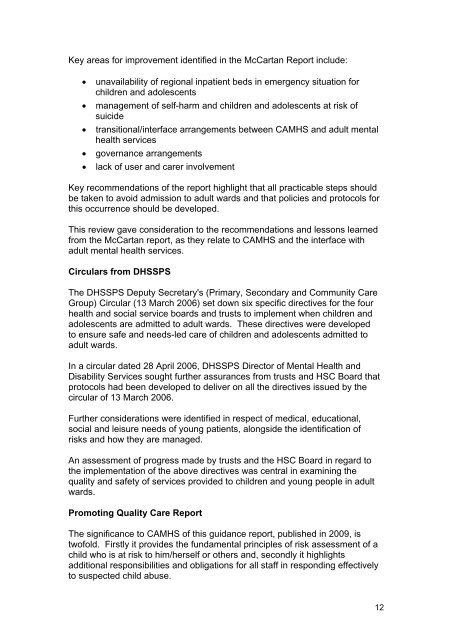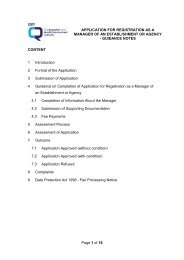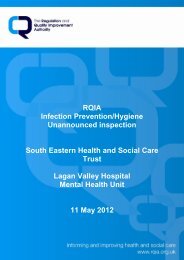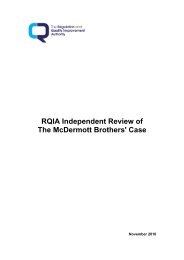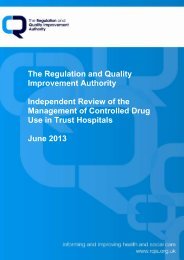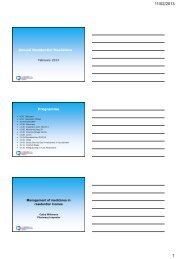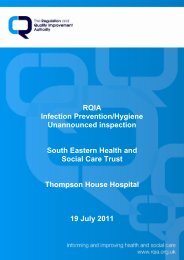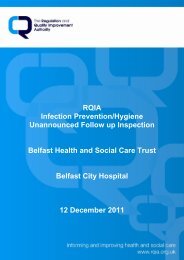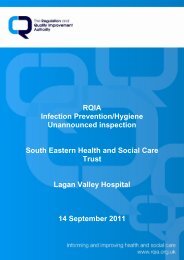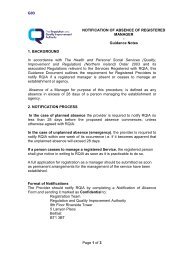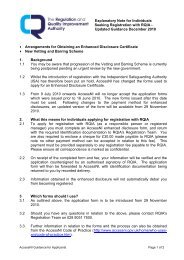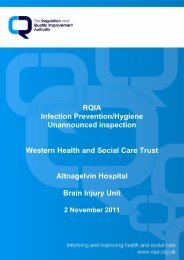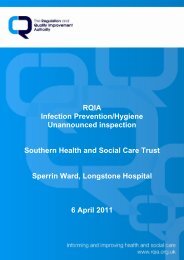RQIA Independent Review of Child and Adolescent Mental Health ...
RQIA Independent Review of Child and Adolescent Mental Health ...
RQIA Independent Review of Child and Adolescent Mental Health ...
Create successful ePaper yourself
Turn your PDF publications into a flip-book with our unique Google optimized e-Paper software.
Key areas for improvement identified in the McCartan Report include:<br />
• unavailability <strong>of</strong> regional inpatient beds in emergency situation for<br />
children <strong>and</strong> adolescents<br />
• management <strong>of</strong> self-harm <strong>and</strong> children <strong>and</strong> adolescents at risk <strong>of</strong><br />
suicide<br />
• transitional/interface arrangements between CAMHS <strong>and</strong> adult mental<br />
health services<br />
• governance arrangements<br />
• lack <strong>of</strong> user <strong>and</strong> carer involvement<br />
Key recommendations <strong>of</strong> the report highlight that all practicable steps should<br />
be taken to avoid admission to adult wards <strong>and</strong> that policies <strong>and</strong> protocols for<br />
this occurrence should be developed.<br />
This review gave consideration to the recommendations <strong>and</strong> lessons learned<br />
from the McCartan report, as they relate to CAMHS <strong>and</strong> the interface with<br />
adult mental health services.<br />
Circulars from DHSSPS<br />
The DHSSPS Deputy Secretary's (Primary, Secondary <strong>and</strong> Community Care<br />
Group) Circular (13 March 2006) set down six specific directives for the four<br />
health <strong>and</strong> social service boards <strong>and</strong> trusts to implement when children <strong>and</strong><br />
adolescents are admitted to adult wards. These directives were developed<br />
to ensure safe <strong>and</strong> needs-led care <strong>of</strong> children <strong>and</strong> adolescents admitted to<br />
adult wards.<br />
In a circular dated 28 April 2006, DHSSPS Director <strong>of</strong> <strong>Mental</strong> <strong>Health</strong> <strong>and</strong><br />
Disability Services sought further assurances from trusts <strong>and</strong> HSC Board that<br />
protocols had been developed to deliver on all the directives issued by the<br />
circular <strong>of</strong> 13 March 2006.<br />
Further considerations were identified in respect <strong>of</strong> medical, educational,<br />
social <strong>and</strong> leisure needs <strong>of</strong> young patients, alongside the identification <strong>of</strong><br />
risks <strong>and</strong> how they are managed.<br />
An assessment <strong>of</strong> progress made by trusts <strong>and</strong> the HSC Board in regard to<br />
the implementation <strong>of</strong> the above directives was central in examining the<br />
quality <strong>and</strong> safety <strong>of</strong> services provided to children <strong>and</strong> young people in adult<br />
wards.<br />
Promoting Quality Care Report<br />
The significance to CAMHS <strong>of</strong> this guidance report, published in 2009, is<br />
tw<strong>of</strong>old. Firstly it provides the fundamental principles <strong>of</strong> risk assessment <strong>of</strong> a<br />
child who is at risk to him/herself or others <strong>and</strong>, secondly it highlights<br />
additional responsibilities <strong>and</strong> obligations for all staff in responding effectively<br />
to suspected child abuse.<br />
12


